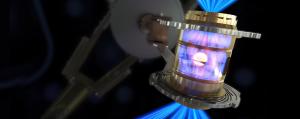Closing a fusion schism
Historically, inertial confinement and magnetic confinement approaches to fusion have been parallel, separate processes. The ITER Private Sector Fusion Workshop in May showed why that no longer necessarily has to be the case.
Fusion historians look back at the 1950s as an age of optimism in the nuclear field. Scientists, infused with a belief that controlled fusion "could be mastered by short-term technological pressure just as uncontrolled fusion had been,"¹ identified magnetic confinement as the method by which fusion power would be achieved. Around the world, scientists embarked on a variety of magnetic fusion concepts, from tokamaks to stellarators to mirror configurations. As the first fission power plant began operations in 1957, fusion scientists hoped that they would not be far behind.
However, experiments quickly revealed that magnetic confinement fusion was a different beast. The understanding of plasma physics was still rudimentary, and a plasma's myriad instabilities could not yet be controlled magnetically to the extent needed for fusion energy gain. Yet, no viable alternative technique existed.
That changed in 1960 with the invention of the laser. Though ubiquitous in the modern world, at the time, the advent of this technology revolutionized fusion science. Scientists such as John Nuckolls in the United States quickly realized that with an implosion system, in which an assortment of lasers simultaneously fire to compress and heat a small amount of fusionable material, fusion-relevant conditions could be created. In 1972, Nuckolls' pioneer paper, "Laser Compression of Matter to Super-High Densities: Thermonuclear (CTR) Applications,"² created a basic blueprint for how a feasible power plant could operate with this method. Today, it is called "inertial confinement fusion."
Nuckolls and others' work led to a sort of "schism" across the fusion community. Magnetic confinement and inertial confinement fusion, while ultimately aimed at obtaining the same goal of usable fusion power, faced powerfully different scientific obstacles. While magnetic confinement programs continued to focus on finding ways to minimize plasma instabilities and optimize confinement, inertial confinement programs had to overcome the enormous technical complexity of laser synchronization as well as implosion instabilities, among other challenges. The timelines of the two technologies gradually progressed, but on parallel paths with little room for collaboration. Indeed, this schism led to a bit of a contest between the two approaches, with experts on both sides at times castigating the other as unrealistic. Magnetic confinement advocates often lamented that inertial designs would be difficult to scale up to power plant efficiency, and argued that the complex configuration of lasers necessary to induce net-gain fusion was unrealistic and expensive. Inertial confinement advocates argued that their approaches are simpler, have a higher energy density, and have a greater level of operational control and repeatability than their magnetic counterparts.
However, both sides of the fusion schism have overcome many of these supposed obstacles in recent years. In 2022, the National Ignition Facility at the Lawrence Livermore National Laboratory in the United States attained scientific breakeven for the first time, obtaining 3.15 MJ of energy from 2.05 MJ, resulting in a Qsci of 1.5. Recent shots at the NIF have yielded even higher Q values, and private companies aim to follow in the NIF's footsteps. On the magnetic confinement fusion side, JET produced a fusion record 69 MJ in its final experiment late last year, while ITER's scientific goal is Q≥10. Other private magnetic confinement fusion approaches project scientific breakeven as well in the coming decade.
This progress on both sides made a historical collaborative event possible at the first-of-a-kind ITER Private Sector Fusion Workshop. At a panel debate on inertial confinement fusion hosted by the CEO of Fusion Energy Insights Melanie Windridge, Ex-Fusion CEO Kazuki Matsuo and Marvel Fusion CEO Dan Gengenbach discussed avenues in which the two approaches could learn from each other.
Signs of schism were nowhere to be found on stage that day. Indeed, it is the very success that both sides have enjoyed in recent years in approaching scientific breakeven that creates collaborative opportunities. After explaining Ex-Fusion's planned pathway to fusion power, in particular the plan for scaling up single-shot approaches to a continuously operating facility, Matsuo explained that the need to capture energy for usable power creates a natural convergence between inertial and magnetic confinement approaches. In particular, Matsuo pointed to the blanket system (which will be largely responsible for the conversion of the fusion process into usable energy) as an area with a significant degree of overlap. "Our blanket systems are very similar. Technological insight and innovation in this area is considered by our community as a key area for collaboration."
Matsuo continued to explain that collaborating on material challenges, as well as diagnostic advancements made at ITER, would help accelerate his own company's progress. He also believes that the regulatory hurdles ITER has gone through has paved a pathway that could advantage inertial confinement fusion companies like his own. "As ITER progresses," Matsuo stated, "it will help define and establish the international standard for safety at fusion power plants."
For his part, Gengenbach believes that sharing some of the software development that has occurred at ITER could help Marvel Fusion achieve its goals. "There are certainly some codes we would love to use," he laughed. He also agreed that there is plenty to learn about the reactor aspect of plant safety regulation, despite "very different technologies."
Both magnetic and inertial confinement fusion approaches still face challenges on the pathway to commercialization. But as the scientists and engineers on both sides continue to doggedly pursue the answers to the remaining obstacles, the knowledge that there are ways to collaborate across the "fusion schism" may just accelerate both sides' pursuit of fusion power.
¹ Furth, Harold P., and Post, Richard F. Advanced Research in Controlled Fusion. University of California (p2), 1964. https://doi.org/10.2172/4618103
² Nuckolls, J., Wood, L., Thiessen, A. et al. Laser Compression of Matter to Super-High Densities: Thermonuclear (CTR) Applications. Nature 239, 139—142 (1972). https://doi.org/10.1038/239139a0



